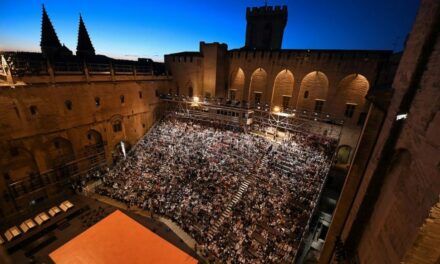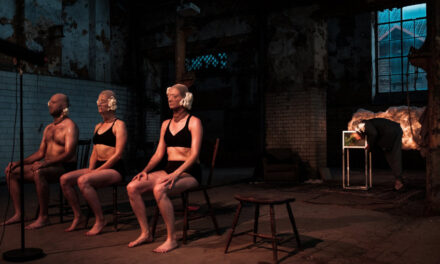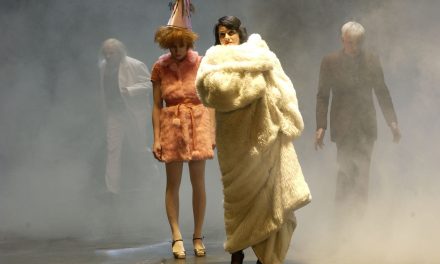The latest performance of the series The Politics of Movement: On Reinterpretation of Power by Milos Sofrenovic deals with the 1968 movement – its symbols, images, and its political heritage. The Brazilian author Vinicius Jatobá and Denise Helene Sumi met with Milos Sofrenovic to address questions around the nature of a revolutionary and as well performative body, the street as a stage for political and performative movement, and its specific visual language. The starting point of the conceptual piece 40’ 33’’: All Power to the Imagination (2018) is an artistic and acoustic landmark, the piece 4’33” (1952) by John Cage, which marked a shift from the representation of an artwork toward an experience of time, space, and the body of an artwork, i.e. the performance itself.
Denise Helene Sumi: Your newest performance 40’ 33’’: All Power to the Imagination (2018) is framed by the piece 4’33” (1952) by John Cage, which deals with the suppressed postwar society by activating attention and awareness through a Zen-like mindset and by illusionary statements, recorded by the NASA for the Voyager Golden Record (1977) to portray the diversity of life and culture on Earth, being rather a very unilateral description. The additional visual material consists of black-and-white images and video recordings of the French student protests in May 1968. Why did you choose these two examples, one from the 1950s and one from the 1970s to frame your study of the protests of 1968? There are multiple events on this timeline one can select.
Milos Sofrenovic: The point of departure while preparing my upcoming conceptual solo performance came from coming across one image by Lynn Rosenthal depicting an event that actually took place in 1968 involving John Cage and Marcel Duchamp playing chess on a chessboard that turned chess moves into electronic music. The two great modernists, by playing chess from 8:30pm to 1am the following morning of March 6, 1968, truly extended life into art and vice versa. I find this moment in time, 1968, fascinating in that two key figures behind some of the twentieth century’s most innovative approaches toward the conceptualization of art practice were sitting across each other playing a performative version of a chess game:
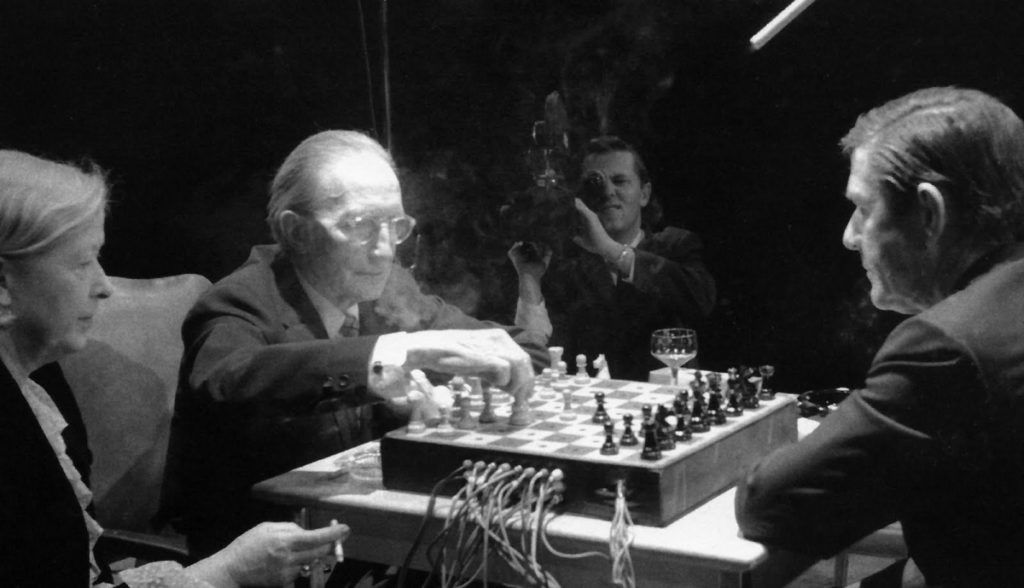
Marcel Duchamp, Teeny Duchamp, and John Cage playing chess, photo: Lynn Rosenthal, 1968
Marcel Duchamp (1887–1968), who has had an immense impact on twentieth-century and twenty-first-century art through a truly seminal influence on the development of conceptual art in general, challenged conventional thought about artistic processes and rejected the emerging art market, through subversive anti-art. John Cage (1912–1992) a friend and admirer of the elder artist is an American experimental composer and author of the remarkable work 4’ 33’’ (four minutes, thirty-three seconds), a three-movement composition created in 1952, as the epitome of an idea that any sounds may constitute music. This is why the program for my upcoming performance contains two thoughts, but also messages given to all of us as a guideline how to preserve vitality of either being an Artist or an Art Observer.
Art work is not completed by the Artist. The work of Art is completed by the Observer. – Marcel Duchamp
I do not agree that life is a game. What we want is an anarchy that works. – John Cage
The events during student protests in Paris in May of 1968 became my latest work’s conceptual framework, as I do believe that the creative power behind French student maxim’s such as “All Power to the Imagination” and “It is Forbidden to Forbid” were in a socio-cultural context communicating a very important need for the realization of the full potential of constructive human ideas. What would come out of it would be the creative freedom and individualism becoming the main qualities of our existence, as also suggested by the new artistic practices proclaimed by Marcel Duchamp and John Cage. On many levels 1968 was – on a global level, in France, Germany, Spain, Great Britain, Italy, Poland, Yugoslavia, Brazil, Mexico, Japan – a turning point of our societies and cultures wanting to step away from massively destructive consequences of the technological progress of capitalism that brought us into twentieth century alongside two World Wars, multiply processes of colonization and capitalistic dictum of a characterless mass being validated as more important than the thinking quality of an individual with integrity.
The fifth and final section of my performance also introduces an eight-minute audio file in which Carl Sagan, the American astronomer and science popularizer, gives a detailed description of his own original concept behind the Voyager Golden Records, two phonograph records that were included aboard both Voyager space crafts, launched in 1977. The intention was for any intelligent extraterrestrial life form, or for future humans who may find them, to become more familiar with the diversity of life and culture on Earth. A rather constructed display of human qualities, we might argue. No information can be found here on protests, wars, aggression, or even self-reflective criticism of humanity of any kind and at any point in time. Therefore I found it very interesting, through applying John Cage’s chance method, to create the juxtaposition of eight minutes of video footage of student protests in Paris in 1968 with eight minutes of audio description of the NASA-produced concept behind the Voyager Golden Records. On one hand, we see the immediacy of a plurality of people on the streets of Paris emphasizing the importance of improvement of “here and now” for the sake of a better future. On the other hand, we hear while watching that video, a male voice of a scientist telling us how the Golden Records are taking the best of us into an unknown future. This discrepancy between the reality of facts and the fabrication of facts gave me a much better understanding of the essence of practically every type of social revolution.
Vinicius Jatobá: While reading the description of what you intend to incorporate into the performance 40’ 33’’: All Power to the Imagination, I wondered about the difficulties you would face to make experienceable the massive number of concepts you have selected to dramatize through your performance. One aspect that interests me is the possibility of seeing May 1968 as a large performance staged on the open field of Paris’s streets into which a large number of bodies, a collective and anonymous body, dramatized and exposed a massive number of concepts and ideas with random energy and reacting to what the city was proposing as resistance to their pleas. Changing, negotiating, improvising. Considering this, how are you preparing your own individual body to channel and stage such a collective experience, which has images of a collective body moving and manifesting itself as its main strength?
MS: This is at the same time a very interesting observation as much as it is a question. First of all, all the selected concepts serving as building blocks of my performance are of course interconnected. The year 1968 served as a beginning of final crumbling of the very conservative society of postwar France, where if we just focus on to the educational system of French universities – it was very formal, rigid, or old-fashioned. It is an interesting fact to look into some figures. France in 1938 had around 60,000 registered students, which became 240,000 in 1961 and in 605,000 in 1968. A 1000-percent increase in a span of only 30 years (1938–1968) is not a fact to be ignored. On the one hand, the country was making studies more accessible, but its format was not being improved.
I am exactly intrigued by the resemblance of May 1968 student protests in Paris to a large happening, a theatrical event challenging the traditional concept of a stage action; relationship between the protagonist and the viewer; introducing nonlinear narrative without a definite duration, unfolding events left to chance and occurring in the present moment, therefore making an attempt to arrest the concept of passing time. Happenings were first utilized by John Cage and his students in late 1950s and later its name was coined by Cage’s student Allan Kaprow. The events of May 1968 were indeed demonstrating the randomness of (inter)reactions and negotiations between the protesters and police forces.
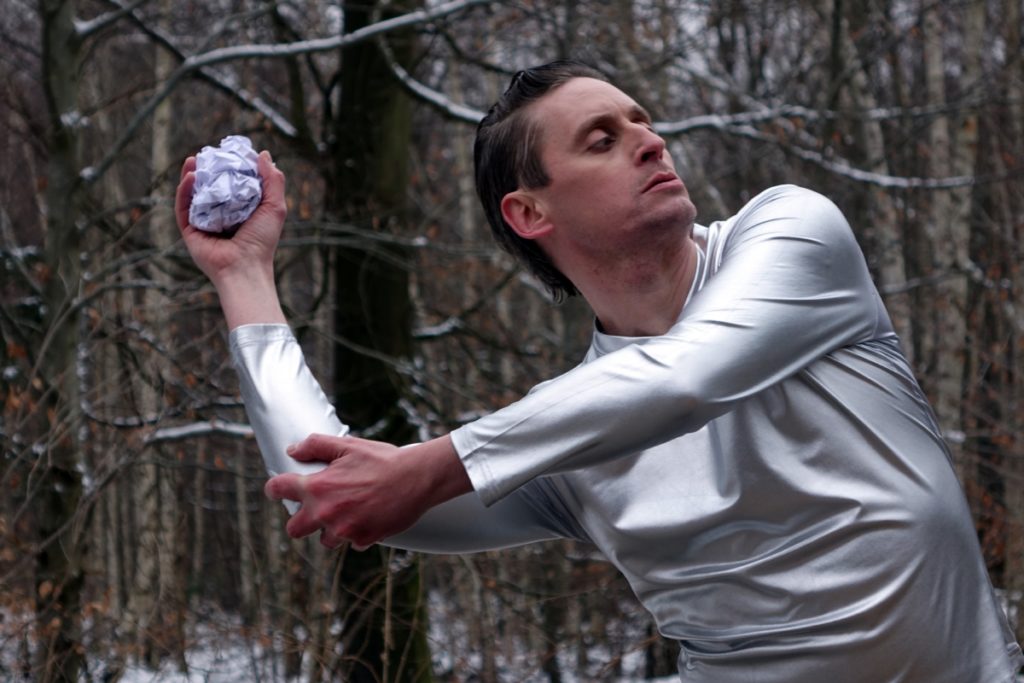
Milos Sofrenovic, 40’ 33’’: All Power To The Imagination, photo: Judith Engel, 2018
Yes, it was very interesting for me to experience how a single body of a performer (myself) embodies and nonverbally channels a collective experience of physical motions collected through my research of the visual data (photo and video archive), capturing the moments on the streets of Paris (e.g. Latin Quarter conflicts between students and police forces).
What also very much helped me in this process of embodiment is the notion that the period in the late 1960s also strongly emphasized the body as an art material communicating among other things its own extreme limits such as in the early works of Chris Burden (e.g. Shoot from 1971) Marina Abramovic (e.g. Rhythm Series from 1973–1974), Vienna Actionists (e.g. operating as a group of artists from 1960–1971).
In Rhythm 5 (1973–1974) Abramovic burned a large Communist five-pointed star in public space while positioning her own body in the middle of it, as a representation of a physical and mental purification, while also addressing the political traditions of her past. All these examples of new art processes that were being self-reflective through exploration of both the meaning and function of one’s own body as art material, while insisting on anti-commercialism in art; establishing a new relationship between the performer and the audiences; utilizing a nonlinear narrative; effects of a new media (television) on creative processes. It was exactly this social turmoil of this period of the late 1960s and early 1970s that strongly shaped and inspired new art practices within which the human body played a crucial role and was able physically to convey the ideas such as Communist oppression in ex-Yugoslavia (e.g. Rhythm 5 by Abramovic) or the Vietnam War crisis (e.g. American Living Theatre’s protest performances in direct relation to this war).
By giving this overview I also wanted to draw a timeline in the development of conceptual body-based practices that have inspired me in making my new work through the emphasis on the importance of EXPERIENCING Time – Space – Material/Body, rather than REPRESENTING it in the form of objects/products exhibited in a museum or on a theater stage. Also, I wanted to explore what makes a Time – Space – Body interrelation between the PERFORMER and the VIEWER more tangible. In the end, it became all about the collective experience, which is reduced to the importance of the process of the unfolding performance becoming more important than the aftermath reflection on the experienced. Seemingly very similar to energy distribution between different parties involved in public protests.
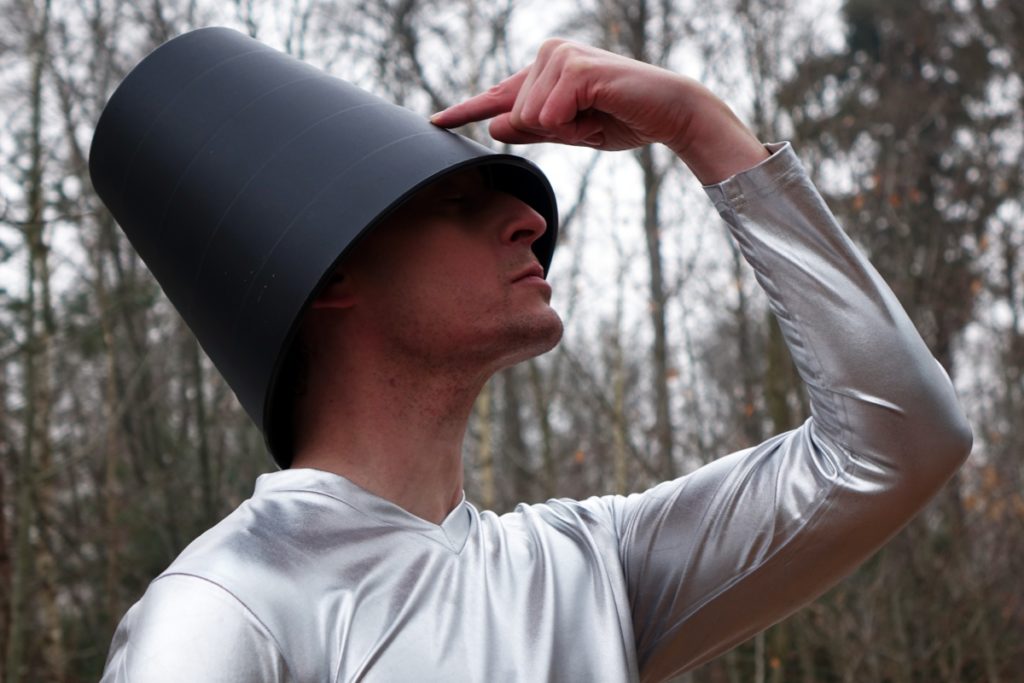
Milos Sofrenovic, 40’ 33’’: All Power To The Imagination, photo: Judith Engel, 2018
DS: Looking back to the protests of 1968 can be controversial, easily mythologized but definitely difficult to repeat. While some might be content to document, dramatize, or mythologize the movement, you try to avoid any of this. What were your personal challenges as a performance artist today dealing with the topic in general, but in particular with this monumental artistic heritage that you have just enumerated, and what was your need to address May 1968?
MS: My need to communicate with 1968, within which the May student protests in Paris also took place, was the notion that the period of the late 1960s in general, was charged with the events such as:
- For the first time, television was entering ordinary homes, and people were able to watch live broadcasts of the Vietnam war or the riots on the streets of Paris, for example.
- In this period, diverse Conceptual/Performance Art practices were getting into a full swing.
- The rise of civil-rights movements in North and South America, Asia, and Africa.
- Black Wave Cinema in ex-Yugoslavia, where I was born and raised, critically examined Tito’s society (e.g. internationally recognized filmmakers Dusan Makavejev, Zelimir Zilnik, Zika Pavlovic, Aleksandar Sasa Petrovic, and Lordan Zafranovic)
It was interesting to realize that this particular period around 1968 was blooming with creativity that was coming out of social-cultural oppression on so many levels. The vitality, optimism, vision, creativity, courage, new perspectives, and rejection of the old modus operandi were giving a new quality to individual countries’ identities of the second half of the twentieth century and also by doing so, moving away from status quo by empowering women, working class, youth, artists, and others.
In the process of creating this work, I was not at least tempted to mythologize, criticize, or idealize the events on the streets of Paris of 1968. First of all, I was not even born then. But nevertheless while growing up, the year 1968 would be part of many conversations around me. Of course, that made me very curious in what is so attractive to many people about 1968. Through this creative research of mine, I suddenly came to a conclusion. There is a timeless quality in this need of the protesters to improve their world, not only on an existential level but also on the spiritual one. This need to have quality of life on simultaneous multiple levels; to be free to be themselves; to be allowed to be part of group that does not have to think one way; to have the right to choose what is best for them; to know that they can also change their points of view through life; to be encouraged to be an active member of the society and not its slave in any way. Those realizations brought even more consciousness to me about my own life within the era I am part of.
The same positive inspiration I found in those conceptual/performance art practices emerging in the late 1960s and throughout 1970s. I like the courage of Marina Abramovic, a female artist under the Communist regime criticizing the system through her conceptual performances by using only a few visual symbols at the time (one of which being her own body) in order to say-question-argue-challenge-refuse plenty. I find it very important today, as this is my time frame of “here and now” that we as artists have to actively discuss different issues through our work (pleasant ones, as well as less pleasant ones); issues which are inevitably part of our lives. For me, active thinking should also be a mandatory act in our daily lives, with full consciousness of constantly improving things and disapproving passivity or comfort.
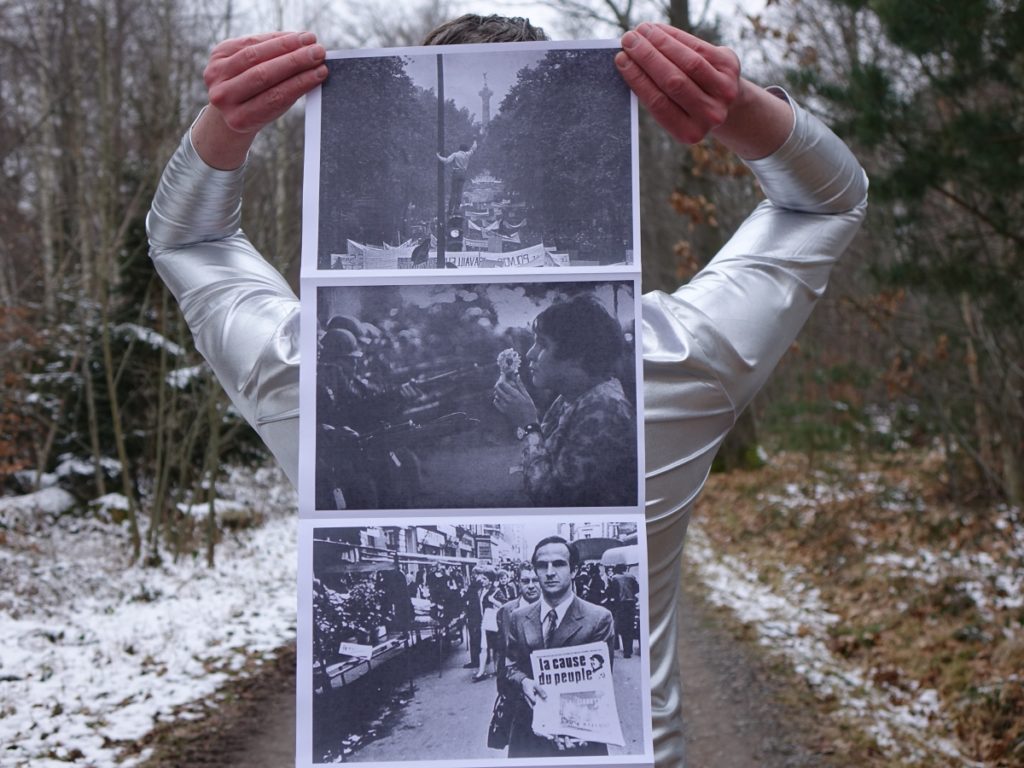
Milos Sofrenovic, 40’ 33’’: All Power To The Imagination, photo: Judith Engel, 2018
DS: The use of simple symbols and the iconography of the protests in your performance, made me think of both Daniel Buren’s readymade pieces of striped canvas, paving the way for Institutional Critique – also one main aspect of the French student protests was a critique of institutionalized knowledge – and the guerrilla tactics of the French BMPT Group [1] , displaying their works in the streets. It seems the visual language of this particular group and the protests of 1968 were in general specifically simple and yet critical. Would you agree with that, how do you deal with the symbols of the protests in your performance?
MS: I agree that the use of simple symbols/iconography of the protests in my performance communicates with the visual language of the protests of 1968. It was simple and yet critical, operating very importantly through humor (e.g. be realistic, ask for the impossible or take your desires for realities, unbutton your brain as much as your trousers). It was a clarity of the wanting to improve the lives of many and the birth and growth of the new left, to the contrast of the luxury of the few protesters operated through simple but effective symbols paroles like the one in the title of my work All Power to the Imagination.
I found interesting in my creative process the different usage of the very same props; like black buckets; white paper in different states; usage of printed images as well as video archive material from the actual 1968 protests in Paris; diverse audio sources such as Golden Records Concept explained by its creator Carl Sagan: polar wind, sound of forest, ravel’s Bolero, Looping Piano.
VJ: One of your main desires as a performance artist is to establish the principle of an open narrative. You expect to have no neutrality from the audience, and you describe this effect as essential to your artistic practice. The most charging energy of performance as an art form resides in its potential of destabilizing the relations between the enclosed language of art expression and the observer’s private mental and emotional space, but I wonder how at this moment, where performance is so institutionalized through galleries and museums, and audiences already know how to see a performance, you can achieve this active attitude of the observer and your proposal. Is it necessary to create a method that makes the audience unlearn how to see and behave as spectators of performances? What do you expect from a performance audience that would make your esthetic proposal complete?
MS: Not to expect anything and to imagine the unimaginable is what in my opinion made my whole process valid and honest from my behalf and which I am ready to share with audience members on March 2 here in Stuttgart.
All the above-mentioned artists’ names consciously or unconsciously were feeding from Marcel Duchamp’s idea that art practice should be a shared experience between the artist and the viewer. This has proven fruitful in particular in the period of late 1960s and early 1970s. I strongly believe that social instability raving at that time across the globe was also making art practices question themselves and therefore offer new formats of communicating the world. The “Open Narrative” method applied in this performance for me is seen also as a way not to define always everything only through oppositions such as the roles of being ACTIVE AND PASSIVE but through a constant FLUXUS of ideas being exchanged between the artist and his observers.
Keywords for me here are exploring the full POTENTIAL of DESTABILIZING the INSTITUTIONALIZATION OF ART and therefore always trying to maintain its position of a CONSTRUCTIVE PLATFORM always ready to question everything including its own FOUNDATIONS. As has always been the case in art history, the point at which the NEW is ready to lose the battle is when the OLD is being taken down. The youth of 1968 was ready to risk everything to improve many aspects of their society at large, and they came close to nearly overthrowing the government at the time. The same thing happened in art practice, which stepped out of museum and galleries milieu and suddenly became an entity with its own integrity. My proposal here is to see where we stand HERE AND NOW in 2018, while 1968 serves as a great example of people being ready to pay a high price to be authentically THEN AND THERE. And they WERE.
- Jump UpThe French BMTP group consisted of the artists Daniel Buren, Olivier Mosser, Daniel Parmentier, and Niele Toroni.
This post originally appeared on Schloss-Post on February 27, 2018, and has been reposted with permission.
This post was written by the author in their personal capacity.The opinions expressed in this article are the author’s own and do not reflect the view of The Theatre Times, their staff or collaborators.
This post was written by Milos Sofrenovic and Vinicius Jatobá.
The views expressed here belong to the author and do not necessarily reflect our views and opinions.


